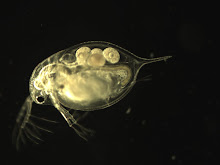Thursday, May 01, 2008
To CG and anyone else who doesn't understand ecology
Regarding your comment to my April 20 post, I have not yet read the article you recommended on littering immigrants, but I will assume you are right and that littering is indeed a problem (but isn't it a problem everywhere - see the link in my April 15 post). However, this border fence is indeed an environmental disaster - I would guess more so than littering - and I will try to explain why. First, there's the easy-to-understand issue mentioned by one of the scientists in the Post article: in some regions the fence will cut off animals from their water supply. Alternative supplies are not easy to find in a desert, so this could be lethal for a population. Second, I'll explain all those issues that I mentioned in my posting that "government asses have no clue about". The ones I listed were dispersal and migration constraints, habitat fragmentation, inbreeding depression, and the keystone species concept. Each organism has its own habitat requirements, including a certain amount of space. That space needs to be large enough (which for many of the endangered large mammals is quite large) so that each individual can meet its energetic needs and stay within its range of environmental tolerances (e.g., temperature, moisture, pH, salinity, etc.). If a barrier is created and the organism can no longer disperse freely, its ability to survive and reproduce is compromised due to many direct and indirect effects (e.g., an isolated population on a remnant habitat becomes too dense, leading to food shortages, leading to local extinction). Besides local extinction, one common outcome of habitat fragmentation and reduced dispersal is inbreeding depression: the population may survive, but decline drastically in numbers, leading to a loss in genetic variation. A loss of genetic variation makes a population more at risk for extinction if disease or another disturbance were to befall the population. Separate from dispersal and habitat fragmentation is the issue of migration. As the Post article mentioned, the U.S.-Mexico border is an important migration route for many animals. Impeding migration could have no impact or multiple impacts, depending on the species. For some species, it will impede their ability to reproduce or reach seasonal feeding grounds. But furthermore, other species that do not migrate may be dependent on those species that do, and thus may be indirectly affected by the impeded migration. Migrating species may transfer nutrients between habitats or otherwise interact with the other species in those habitats in important ways. One example I can think of is from research done by an INHS ornithologist. I can't remember what bird species it was, but there is a certain species that gives out alarm calls when a predator is approaching. These alarm calls are understood not just by its conspecifics but by the other bird species in the community as well. If the alarm calling species fails to migrate back north, the other bird populations dwindle because that species is no longer around to warn them. This brings me to the keystone species concept. A keystone species is a species who has a disproportionate impact on the environment, compared to its biomass. Wikipedia has a decent explanation. For example, Paine's classic study shows that when the starfish, an important predator, was experimentally removed from the intertidal ecosystem, the result was not simply an ecosystem with no starfish, it was a total collapse of the ecosystem - the starfish's prey, the mussels, took over and drove all the other species to local extinction. Sometimes the impact a species has on an ecosystem is not apparent until that species is removed. Even if a species isn't a keystone per se, every organism interacts with other species and its environment, so its removal can still impact other species. The main point here is that you can't look at this border fence issue and say, "well who cares, only the antelope, jaguars, and ocelots are going to be affected". Because the reality is that a lot more organisms than we know are going to be indirectly affected, and these indirect effects won't become evident until it's too late. Everything is connected, and most of those connections are really hard to discern but are nevertheless important. This is not "gloom-and-doom" or unrealistic, it's a scenario that's already played out in so many over-developed and fragmented regions where we've lost biodiversity. I think it's really sad, but maybe you're one of those people who needs to visit places in person to appreciate their significance and irreplaceable qualities (hopefully you're not one of those people who has no appreciation for nature unless there's $ involved :) I think ecology (not just general biology) should be required for every high school student to understand this basic stuff about how nature works.
Subscribe to:
Post Comments (Atom)

No comments:
Post a Comment